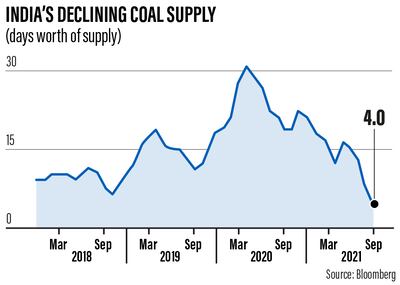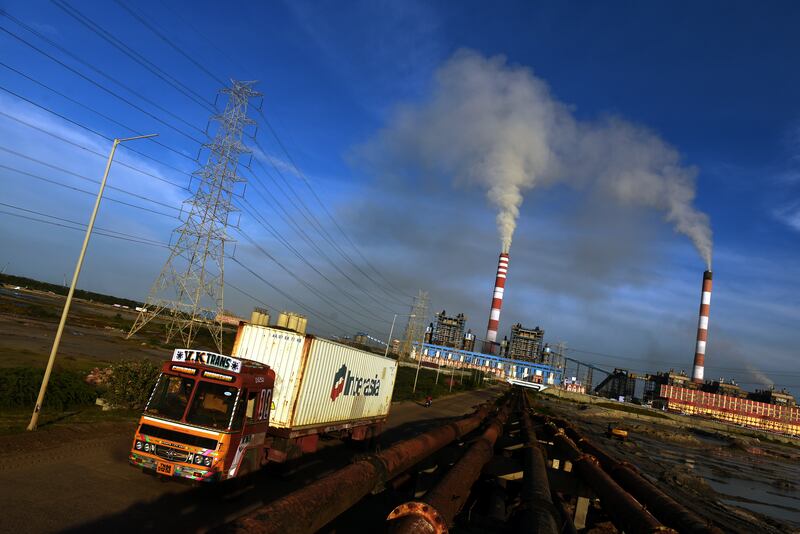India is facing a looming power crisis as coal supplies run low.
More than half of its 135 coal-fired power plants have less than three days of fuel stocks, according to data from the Central Electricity Authority. The country remains deeply dependent on the fossil fuel, despite the government’s push towards renewables.
“The supply crunch is really serious,” said Jyoti Gadia, managing director of the Resurgent India investment bank. “Countries like China are already facing power cuts and a similar situation may arise in India, too, if supplies are not ramped up.”
Coal accounts for about 70 per cent of the electricity generated in India. The imminent shortage could pose a major risk to India's economic recovery, analysts say.
“Coal is not a resource that can be tapped at will, so this shortage threatens to slow down India's economy for weeks,” said Tanushree Banerjee, the co-head of research at Equitymaster.
Despite having the fourth largest coal reserves in the world, the country is heavily dependent on coal imports. India is the second largest coal importer after China, with its supplies coming largely from countries such as Indonesia, Australia and South Africa.
However, a surge in global coal prices amid rising demand has prompted India to scale back its imports. This has resulted in a rush to get hold of the country's limited domestic supplies, which are insufficient to meet its needs. Supplies have been further limited by heavy rains during September, which hampered coal mining.
A coal crunch comes as India’s economy is gradually relaxing curbs imposed due to a severe wave of Covid-19 infections. The country’s power consumption has surged as a result, with average power demand rising by 23 gigawatts between Aug. 1 and August 23 to 186 gigawatts, according to data from S&P Global Platts Analytics.
“There has been a sudden spurt in the power demand, which is unprecedented,” said Pradeep Multani, the president of the PHD Chamber of Commerce and Industry, a trade and industry body based in Delhi. “This has substantially increased the consumption of coal by the thermal power plants.”
It is likely that “energy supplies may remain constrained for some time”, he added.
The shortage of coal is already taking a toll on some sectors.
“If the crisis deepens, it may have a more broad-based impact on the economy,” said Vinaya Varma, the managing director of mjunction services, an e-commerce platform that provides online coal sales services in India. He said the shortages had already resulted in a supply crunch for non-power sectors, which depend on coal, including cement, steel and aluminium.
India's economy has been bouncing back after it fell into a historic recession last year because of the effects of the pandemic. It was hit hard again in April and May by the deadly second wave of infections. Fitch Ratings has pegged its growth forecast for India at 8.7 per cent for the current financial year.
The latest supply crunch could lead not only lead to power cuts but also to inflation, as the costs of imports are likely to be passed on to consumers — either directly through electricity price rises or indirectly by businesses.
“While a broad-based tariff increase cannot be done overnight, due to approvals needed from state and central regulators, power prices may go up for units which are allowed to do variable cost adjustments on a monthly basis,” Mr Varma said.
Meanwhile, state-owned electricity distribution companies, which are already heavily indebted, could be affected by the crisis too.

However, the only near-term solution may be to turn to costly coal imports. It will be impossible for India to ramp up coal production overnight because of the amount needed, industry insiders say.
State-owned Coal India, which is responsible for more than 80 per cent of the country's coal production, is working with the government to mine more fuel to meet the shortfall.
But “meeting the gap immediately [through domestic sources] is not possible due to the time lag that exists both in expanding current projects, which takes two to three years and opening new projects, which takes four to five years”, Mr Varma said.
Land acquisition for coal mining is also a major hurdle, which has hampered domestic production. There are other inefficiencies in the largely state-controlled system, including transportation.
“India's cheaper domestic coal supplies have been inadequate for many years now,” said Ms Banerjee.
With India's power demand expected to grow rapidly over the coming years, driven by trends including urbanisation and the predicted rise of the economy, the issue is becoming more and more pressing. The International Energy Agency forecasts that the country's energy consumption will double over the next two decades.
Although India is rapidly scaling up its renewable energy production, with solar energy being the main source, it will not be enough to meet the country's expanding energy needs in the near to medium term. As a result, coal is expected to remain a major part of India's energy mix for years to come.
“While the coal shortage problem may be temporary, India's power sector needs immediate reforms to streamline coal supplies,” said Ms Banerjee.
In the longer term, India, does want to reduce its dependence on coal, which is a major source of carbon emissions. The country, which has some of the world’s most polluted cities, has promised to lower its carbon footprint under the Paris climate accord.
“Less reliance on coal-based power plants is the ultimate long term solution,” said Mr Gadia.
As part of the country's plans for a greener future, its coal ministry this month asked Coal India to diversify its business into possible areas including electric vehicles and charging pods.
The move will help India become more sustainable and “will strengthen energy security, control the climate risk and ensure accessibility to affordable energy” in the long-term, Mr Multani says.
But in the immediate term, the crisis only seems to be escalating.
Some parts of northern India including Bihar and Rajasthan are already facing power cuts, according to Reuters.
A report by Crisil Research, which is part of S&P, estimated that coal inventory at the thermal plants will only improve next year — a prediction echoed by India’s power minister Raj Kumar Singh in an interview with the Indian Express newspaper.
Although there may not be an easy short-term solution at hand, the country needs to prepare better to avoid such problems until it builds significant renewable energy capacity, experts say.
“India is going to depend grossly on coal for at least another decade,” said Mr Varma.
“To avoid such problems in future, the power utilities need to maintain the prescribed stock of coal during lean times. While that would lock up capital, that is the only way to pre-empt such a crisis.”






